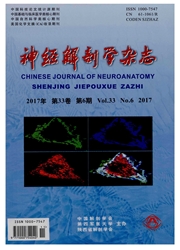

 中文摘要:
中文摘要:
目的:建立选择性荧光标记小鼠胚胎脑组织移植块移植模型并观察选择性荧光标记的神经元在成体脑组织中的存活、发育和投射。方法:将孕龄14~15 d选择性荧光标记的胎鼠脑组织块移植到受损的普通小鼠大脑皮层中,2个月后用荧光显微镜和共聚焦显微镜结合Nissl染色的方法观察胚胎脑组织移植块内选择性荧光标记的神经元在受体大脑中的生长发育情况。结果:在胚胎脑组织移植块内观察到只有少部分神经元被标记,这些类似于Golgi染色模式的选择性荧光标记的神经元有大量的神经纤维投射到受体鼠的不同脑区。通过Nissl染色和共聚焦成像发现胚胎脑组织移植块内神经元能分化并形成典型的突触结构-树突棘和突触终扣。结论:胚胎脑组织移植块内选择性荧光标记的神经元在受体脑内能够存活并特异性地表达荧光,这些标记的神经元具有正常的形态结构,可以投射到各个脑区并参与神经回路的重建。
 英文摘要:
英文摘要:
Objective: A fetal neocortical tissue transplantation model was established to image the survival, development and projection of selectively fluorescence-labeled neurons in grafted fetal neoeortical tissue in the host motor cortex. Methods:Blocks of fetal cortical tissue from transgenic mice ( El4 -E15 ) were transplanted into cortical lesion cavities in host brains. Confocal microscopy, fluorescence microscopy and Nissl staining were used to examine the survival and development of selectively labeled neurons in grafted embryonic tissues two months after transplantation. Results:Sparse fluorescence-labeled neurons were observed in the transplanted fetal cortical tissues. Axons of the Golgi-like vital stained neurons were found to project to many cortical regions of the host brain. Nissl staining and confocal microscopy indicated that neurons from fetal neocortical tissue developed typical synaptic structure-spines and boutons. Conclusions:Fluorescence-labeled neurons from fetal neocortical tissue survived and selectively expressed fluorescence in the host brain. These labeled neurons had normal morphological structure and projected to different cortical regions to rebuild the damaged neural circuit.
 同期刊论文项目
同期刊论文项目
 同项目期刊论文
同项目期刊论文
 期刊信息
期刊信息
